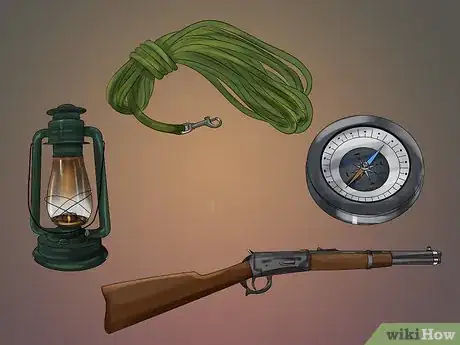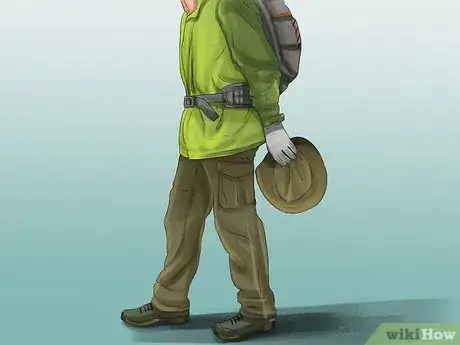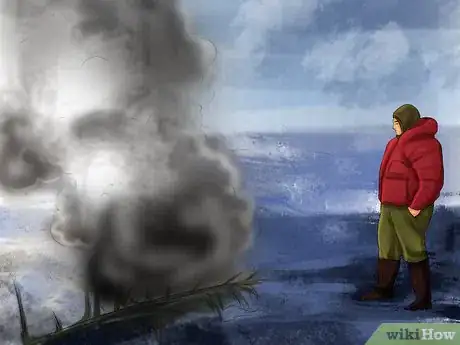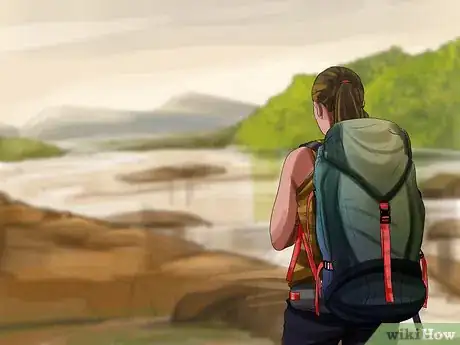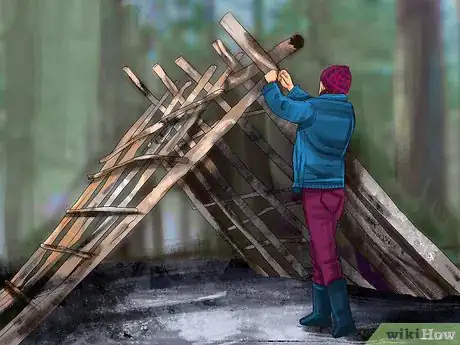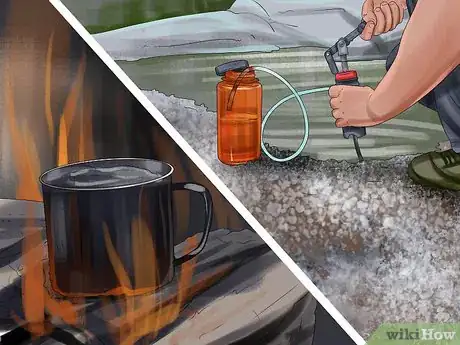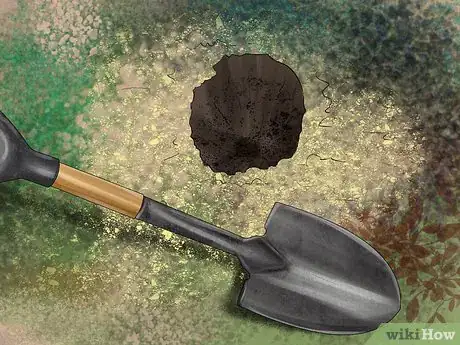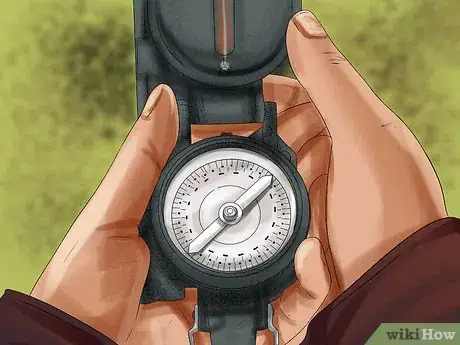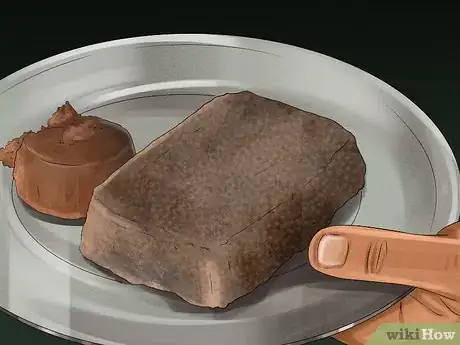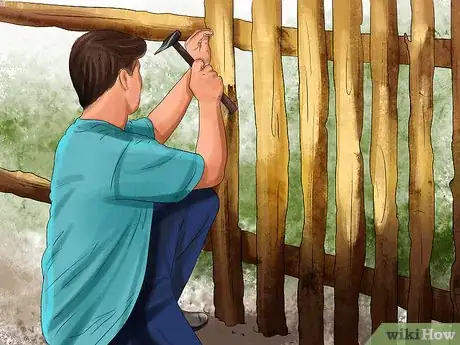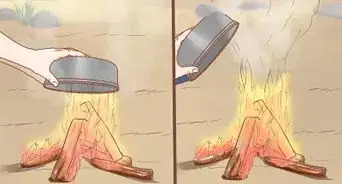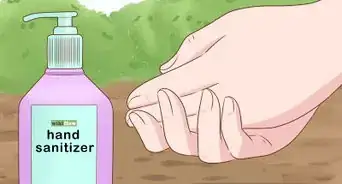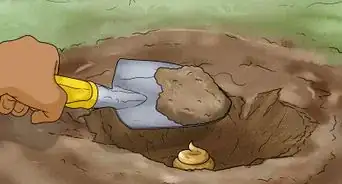wikiHow is a “wiki,” similar to Wikipedia, which means that many of our articles are co-written by multiple authors. To create this article, 91 people, some anonymous, worked to edit and improve it over time.
There are 11 references cited in this article, which can be found at the bottom of the page.
wikiHow marks an article as reader-approved once it receives enough positive feedback. In this case, 89% of readers who voted found the article helpful, earning it our reader-approved status.
This article has been viewed 786,843 times.
Learn more...
John Muir once said, "Thousands of tired, nerve-shaken, over-civilized people are beginning to find out going to the mountains is going home; that wilderness is a necessity."[1] Does anyone need more of an explanation than that? Though life will be simpler in the wilderness, taking the steps to get there is not. But with the right knowledge, skill set, and equipment, you'll be prepared for a successful transition.
Steps
Preparing to Go Off-Grid
-
1Figure out the course of action appropriate for your environment. The skills needed to stay in subzero Alaska versus the woods of mainland Europe versus the Sahara Desert are all incredibly different.[2] Think of these vary basic things first:
- What time of year would make it easiest to get started?
- How many supplies would you need to start off with?
- Would you have access to civilization? How far away would it be? How does this change your situation?
- Try to buy a map of where you are going (if you can) before you leave.
- Do you have the skills to survive in the terrain/climate you're considered?
- Do you need time to adapt your body? (to extreme weather, for example)
-
2Practice "survival techniques" at home before you need them. It all depends on where you're going, but odds are you'll need to be in shape (so start exercising now) and will need some basic backpacking techniques mastered, too. Get the skills down you think you'll need, and don't forget first aid!
- Consider doing crazier things, like learning to eat insects and grubs. Then, if you're in a sticky spot, you'll be more likely to succeed.
Advertisement -
3Work out a supply list. You're not getting stuck in the woods for 3 days, you're living out there for a lengthy period of time. Just having a backpack with a few granola bars and a sweater won't cut it. Here is a basic list of what you may want to take with you:
- Utility items (rope, knives, netting, etc.)
- Rifle and/or shotgun (guns in cold condensate and will have to be taken care of)
- Lantern and flashlights (with oil and batteries)
- Dried food (oats, lentils, beans, rice, coffee)
- Source of vitamin C (Tang, for example)
- Water filter
- Compass and Map of Area
- Blankets
- Fire steel, matches, etc.
- Axe
- Flares, mirrors, whistle, etc.
- Radio
- Tool and sewing kit
-
4Bring the right clothes. Three rules: cotton kills, friends don't let friends wear cotton, and cotton is rotten. You want to have clothes that retain their warmth even after they're wet. You want clothes that can survive wear and tear. Cotton, though it's light and comfortable, is not the way to go. Pack your bags with clothing made for loggers, surveyors and commercial fisherman. It's going to be heavy, but it's going to last.
- Remember: you can always take layers off if you get hot. It's better to have too many clothes than to not have enough, after all. If something happens to one, you'll have something else equally as warm. Marino wool is very insulating and cannot easily get wet. Some jackets are made of Marino, so try to get your hands on one of them.
- Get a shell jacket and pants for rain and snow. Most cases of hypothermia happen in temperatures under 40 °F (4 °C).[3]
-
5Consider taking classes before you leave.[4] Surviving, let alone living, in the wilderness is no joke. You're best off if you have some type of training before you venture into the fight of you versus Mother Nature. Contact local wilderness groups or adventure-based organizations to rack up some useful experiences to your name. The more you know what to experience, the easier it'll be.
- Learn to identify poison ivy, poison oak, or poison sumac, in addition to other poisonous plants (and avoid them). What's more, there are some plants (cow parsnip) whose sap makes your skin hyper photosensitive. That is, the sun will cause your skin to painfully blister. It's best to know your terrain to the best of your ability.
- And the calmer you'll be able to stay, which is of utmost importance. If you've seen a situation before, you'll know what to do and you'll be able to relax. If you're nervous and unsure, it's possible you could make a grave mistake. Getting trained is a way to avoid future mishaps.
-
6Collect your belongings in a backpack that has everything you need but is easy to carry.[5] Living in the wilderness will mean lots of exploring and foraging. You'll need plenty of supplies for your home-base, but you'll also need to figure out what you can pack with you on the go. Get a sturdy, legitimate camping pack that you can depend on for when you need to venture outside.
- Pack your backpack before you leave to see how much it can carry. Get familiar with how you can pack it to the brim and still be able to carry it. Even packing skills come in handy in the wilderness.
-
7Know how you'll signal for help if you need it. Again, this is largely determined by the gear you have and where you are. However, here are a few basic ideas that you'll likely want to be prepared for:[6]
- Know how to build a signal fire
- Use a mirror or similarly reflective object to flash the horizon
- Send an SOS signal, if possible
- Use emergency beacon devices such as ACR or SPOT
Setting Up Camp
-
1Pick a safe and secure site where you can stay. Choose a sight close to a water source but far enough anywhere you will not be in danger of animals (who also tend to stay around water) and high tides.[7]
- It should also be on stable ground. Avoid drop-offs, areas that are too rocky, or areas too close to water. All of these are areas that are vulnerable to the elements.
-
2Build a fire.[8] Warmth is the essence to comfort in the wild. But just knowing how to make a fire is not enough – you've got to know when and how, too. Here are a few details:
- Build a fire away from your valuables and away from your food supply, should anything go wrong (animals included).
- When you cook with fire, do not use a flame right away, but instead build a fire and let it sit. You should build a fire long before you eat. In the process of building a fire, you create a hot bed of coals which will create an open flame. This open flame will allow you to burn your food to a black crisp.
- Look for birch bark to start a fire. Birch bark, wet or dry, is highly flammable and is great for starting fires in wet or cold locations.
- Burning hemlock bows keeps away flies and mosquitoes.
-
3Build a shelter.[9] A lean to is an easy way to construct a shelter, albeit it won't last forever. For the first week or so, have a basic structure you can sleep in. Spend that time building something more permanent. The longer you plan on being out there, the better built it should be.
- It is highly recommended to never sleep on bare ground, and to always make the floor of your shelter something like hemlock bows, leaves or hay; if you do not make the floor of the shelter with hemlock bows, leaves or hay, you will freeze when you sleep on the dirt.
-
4Make water a priority. You can last without food for up to a month, but water is essential. Stake out a water source that you can reliably depend on. If you can, get your water in massive quantities so you don't have to keep going back day in and day out.
- Also, you can collect morning dew from grasses and leaves with a clean cloth (rag) and squeeze it out into a container. It may not be the cleanest, but it will help to keep you hydrated.
Meeting Your Basic Needs
-
1Learn how to hunt, trap, and gather. Again, this is contingent upon your location. However you need to get food, learn how to do it. Tap into all your resources: rivers full of fish, animals in the sky and on the ground, and the plants that surround you. The more skills you have, the better off you'll be when the climate changes or when certain resources run dry.
- Do not eat any plants unless you know that they are edible. If you can, bring a book discussing the flora and fauna of your local. Or start your own garden.
- As a general rule - if you kill an animal when it is acting normally, then it should be safe for you to eat it. Ensure that you have the knowledge and resources to preserve meat and fish so that it does not spoil. Do not attempt to eat an animal that appears visibly sick or is dead when you find it.
- Have a good storage system, too. There may be scavengers in your area that pose a threat to your food stock.
-
2Make sure your water is purified. Drinking purified water is critical as you can get many diseases from dirty water. You never know if a freshwater system is actually clean (for instance, there could be a dead animal upstream from you), so purify all your water.[10]
- The easiest method is to boil your water. It should take about 10 minutes.
- Another is to use iodine tablets (not liquid iodine from the drug store). Use the iodine tablets according to directions that are provided on the label.
- A third method is to use a water filter. Pre-filter the water with a bandana or other piece of material. Then use the filter on that dirty water. The minimum size filter you need is 1 or 2 micron. This allows particles of 1 or 2 micron in size to pass through the filter. The smaller the micron size, the better the filter, and the slower the water will come out.
- A gravity filter is easiest, if you can bring one with you. You pour the water in, do more chores, and an hour or two later return to find fresh water.
-
3Keep separate "dirty" and "clean" water containers. Never get a single drop of dirty water in your clean container. All it takes is one drop to get a deadly illness.
- To sterilize your clean container again, boil it in water for 10 minutes. Make sure all parts of the container are under water while boiling.
-
4Figure out how to “take care of your business.” When you need to poop, you need a toilet (or something similar) away from your source of water, away from your shelter, and away from your food. This can be in the form of a hole in the ground or something less temporary, like an outhouse.
- If you've constructed an outhouse or similar structure, know that in winter, your butt will freeze to wood. Use styrofoam over your toilet seat to avoid a rather unfortunate event from happening.
-
5Learn how to walk in a straight line. Seriously – learning how to navigate wherever you are is incredibly important for your success. Surprisingly, even just walking in a straight line is nearly impossible (humans tend to walk in circles inadvertently). The most basic way to avoid this is to line up landmarks, which is called "marking" and "backmarking" (turning around and making sure your backmark is directly behind you).
- You can use trees, the moon, and the sun to navigate, too. If you're the type that has an internal compass, this will come easy to you.
-
6Carry pemmican with you whenever you go off on a trip. This is dried meat and rendered fat.[11] Make your own favorite recipe at home in large quantities for when you need to take a two week trek down to the nearest town. You'll be glad you did.
- Pemmican requires no cooking (just drying) and if you have enough fat in the mix, will sustain you longer than any other "survival food". You can live on it for months in any situation, even at home.
Staying Long-Term
-
1Be your own doctor. Being alone in the wilderness means that you'll be your own doctor. You'll be your own everything, really. If you were to get so much as a cut, it needs to be addressed (it could be infected).[12] Hopefully you have basic first aid knowledge and can take care of everything from sterilization to putting on a splint.
- If you break your leg (or something similarly terrible happens), have a way that you can contact for help, whether it's a radio, a phone, or some other reliable signaling mechanism. Having this ability will help take the stress off should something happen.
-
2Consider starting a garden. Since you're going to be on your own for a while, why not start a garden? It'll be your own little farm, and it'll be a source of food you can count on that's almost effortless (apart from the beginning stages). It'll also be a morale boost, being resourceful and in control of your survival.
- Be sure you can keep your garden away from wild animals. Construct a fence around your garden, use objects to scare them away, and "mark your territory" if need be.
-
3Stock up for the winter. If you choose to go to a climate where winter is prevalent, you'll need to stock up for when your world freezes over. Animals will be harder to find, walking around will be harder to do, and just staying warm will be difficult to maintain. When fall comes around, make sure you're stocked up.
- Keep a few months' supply of food on hand, if at all possible. If you have access to a meat freezer, then try to shoot a deer or large game animal in the late fall.
- The same goes firewood. Move it inside, if at all possible.
- The water will be ice in winter, so keep fresh, clean water inside, too.
-
4Bulk up your shelter.[13] In six feet of snow or in torrential rain, your little lean-to isn't going to do much good. Spend summer and fall building something similar to a cabin to keep out the elements and wild animals. It'll feel more like a home, too.
- Figure out a way to bring your outhouse to you for the winter, if at all possible. It can be closer to your shelter, though it shouldn't be inside your home (unless you want the stink).
-
5Get a source of vitamin C. One of the last things you want is scurvy. You're not a sailor in the 1700s, so don't let your teeth get soft and your body deteriorate. If you don't have your own source (like dried Tang powder), rose hips work. They're not the tastiest, but they work. Pine needles are awesome too. They actually have more vitamin C than citrus fruits. Just cut some up and boil them to a tea, but watch out not to use needles from yew (taxus) trees, because they are poisonous.[14]
- Your diet is essential to your survival. The more balanced it is, the better. Try to get all your major food groups so you can stay strong and healthy. If you don't, you risk compromising your immune system and being susceptible to even the weakest of bacteria and viruses.
-
6Learn how to predict the weather. Let's say you're running out of supplies and need to get down to the nearest general store, about a week's hike away. If you don't know how to predict the weather, you'll venture off whenever you see fit. But if you do, you may be able to predict that a storm is coming and wait it out – or do it as quickly as possible.
- This means detecting changes in air pressure, recognizing cloud systems, and even noticing smaller things, like how the smoke is rising from your fire (swirling smoke is not good). Animals can give you signals, too.
-
7Realize that if you go back to city life, it'll be quite the shock. Once you've abandoned the life of money, status, and 9-5 jobs, going back may seem like more of a feat than leaving. For some, it is mentally compromising. Carefully weigh your options as logically as possible if you're considering a transition.
- You may want to take small steps. Moving to a farm or a rural area may be better than trying to go back to city life, at least immediately. Don't give a shock to your system if you don't have to. Baby steps will make it easier.
Expert Q&A
-
QuestionHow do you make an easy shelter in the woods?
 Josh GoldbachJosh Goldbach is an Outdoor Education Expert and the Executive Director of Bold Earth Adventures. Bold Earth leads adventure travel camps for teenagers all over the world. With almost 15 years of experience, Josh specializes in outdoor adventure trips for teens both in the United States and internationally. Josh earned his B.A. in Psychology from Eckerd College in St. Petersburg, Florida. He’s also trained as a wilderness first responder, a Leave No Trace master educator, and a Level 5 Swiftwater rescue technician.
Josh GoldbachJosh Goldbach is an Outdoor Education Expert and the Executive Director of Bold Earth Adventures. Bold Earth leads adventure travel camps for teenagers all over the world. With almost 15 years of experience, Josh specializes in outdoor adventure trips for teens both in the United States and internationally. Josh earned his B.A. in Psychology from Eckerd College in St. Petersburg, Florida. He’s also trained as a wilderness first responder, a Leave No Trace master educator, and a Level 5 Swiftwater rescue technician.
Outdoor Education Expert A debris shelter is a good option if you're in a pinch and need to make a shelter in the forest. Look for a long, solid stick that you can lean up against a tree. Then, build a structure of sticks along that and fill in the gaps with debris (like leaves). You want to stack that debris at least 1 ft (30.5 cm) or higher.
A debris shelter is a good option if you're in a pinch and need to make a shelter in the forest. Look for a long, solid stick that you can lean up against a tree. Then, build a structure of sticks along that and fill in the gaps with debris (like leaves). You want to stack that debris at least 1 ft (30.5 cm) or higher. -
QuestionIf I see a wolf and I want to go up to it, what do I do?
 Community AnswerPrepare for it to ether run away or possibly harm you. It is best to leave wolves alone.
Community AnswerPrepare for it to ether run away or possibly harm you. It is best to leave wolves alone. -
QuestionWhat gadgets and tools do I really need?
 Giacomo0097Community AnswerA knife, a fire starter and a pot or another metallic container that you can boil water with.
Giacomo0097Community AnswerA knife, a fire starter and a pot or another metallic container that you can boil water with.
Warnings
- Do not touch a bush with red stems.⧼thumbs_response⧽
- Relying on Iodine-Purified water for more than about 5 weeks can begin to upset your stomach. If you happen to have enough tablets to last for that long, try boiling some water, too.⧼thumbs_response⧽
- Do not touch anything with shiny leaves and beware of plants that have three leaves.⧼thumbs_response⧽
- Black bears can often be scared away with loud noises. Brown bears and polar bears however are attracted to noise, the trick is to know where all three roam.⧼thumbs_response⧽
- Don't eat mushrooms, on average 80% percent are poisonous. Do not eat a mushroom unless you know what it is.⧼thumbs_response⧽
- Do not eat ferns as some are poisonous. However if you contract an intestinal parasite those same ferns can be ingested in small amounts to rid yourself of the parasites.⧼thumbs_response⧽
- Try to battle your fears and win them over. It will help in your future life.⧼thumbs_response⧽
- Always stay calm and busy, by accomplishing set tasks; confidence grows and will improve your ability to survive.⧼thumbs_response⧽
- Don't leave your tent un-zipped during night. Wild animals have tendencies to crawl inside and some are dangerous.⧼thumbs_response⧽
- Do not eat anything that has a milky liquid bleed; exceptions to this rule are dandelions and milkweed, both are edible and palatable if cooked correctly.⧼thumbs_response⧽
- When you go in the woods expect large swarms of painful insects wherever you go and prepare for the eventuality of meeting them. Beware dusk and dawn both often signal the onset of these swarms.⧼thumbs_response⧽
- Don't sleep in the clothes you cooked in -- the scent will linger on your clothes and body, attracting bears and other animals.⧼thumbs_response⧽
- Never go near an animal's young, especially bears and exotic cats.⧼thumbs_response⧽
- Beware of colorful animals (generally bugs and snakes). They are often deadly and their stunning colours tell other animals to STAY AWAY! Examples of these animals are the poison dart frog, the coral snake and the Monarch Butterfly.⧼thumbs_response⧽
- Tell someone you are going, where and for what time before you leave, so they can contact you when you are in danger.⧼thumbs_response⧽
Things You'll Need
- Water Source (creek or river)
- Food source (small game and plants)
- Warm clothing
- A way to start fires
- Thick, warm blanket
- Small skillet, small bowl and plate, fork, knife, and spoon.
- Multi-tool or Swiss army knife
- Firearm
- Bug spray
- Flash light
- Bandages
- Medicine
- Weapon (in case of attacks)
- Water jug (in case of no water source)
- A device that can be used to communicate someone when in need.
- Camera (can be used to prove evidence if you are attacked by a wild animal and take scenic shots)
References
- ↑ http://www.goodreads.com/quotes/tag/wilderness
- ↑ http://survival-mastery.com/skills/bushcraft/living-in-the-wilderness.html
- ↑ http://survivalcache.com/wilderness-survival/
- ↑ http://survival-mastery.com/skills/bushcraft/living-in-the-wilderness.html
- ↑ http://survival-mastery.com/skills/bushcraft/living-in-the-wilderness.html
- ↑ https://www.outdoorlife.com/photos/gallery/2014/09/11-ways-signal-help/
- ↑ https://www.popularmechanics.com/adventure/outdoor-gear/a25095391/how-to-set-up-camp/
- ↑ https://www.popularmechanics.com/adventure/outdoor-gear/a25095391/how-to-set-up-camp/
- ↑ https://www.outdoorlife.com/photos/gallery/hunting/2013/05/survival-shelters-15-best-designs-wilderness-shelters/
- ↑ https://authorizedboots.com/17-best-ways-to-purify-water-in-the-wild/
- ↑ https://www.wildernesscollege.com/pemmican-recipes.html
- ↑ https://www.outsideonline.com/1920651/5-essential-survival-tips
- ↑ http://www.bcadventure.com/adventure/wilderness/survival/basic.htm
- ↑ http://www.wilderness-survival.net/forums/showthread.php?8382-Wilderness-Living-How-It-Really-Works
About This Article
To live in the wilderness, start by learning survival techniques like hunting, first-aid, gardening, and shelter-building by taking wilderness survival classes or studying independently. Next, make a list of the gear and supplies you'll need and pack them into a travel bag that's easy for you to carry. Then, choose a safe area near water to set up your camp site and build a shelter. Finally, get a fire going, plan your first meal, and start your new life in the wilderness! For tips on hunting and trapping food, read on!


